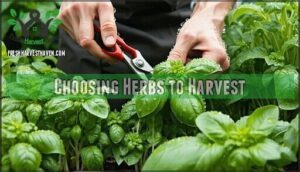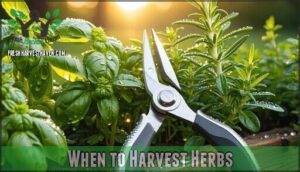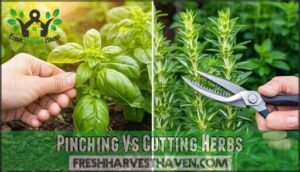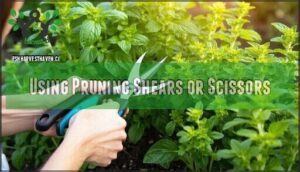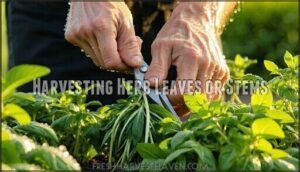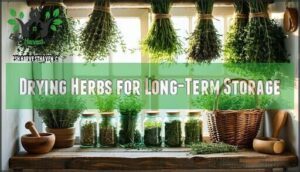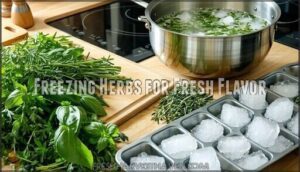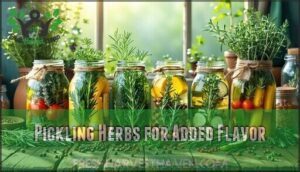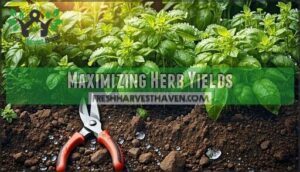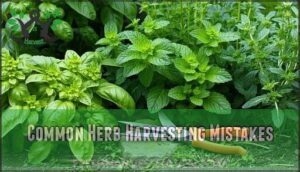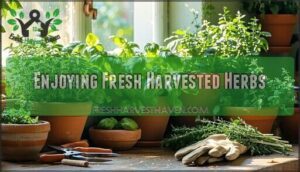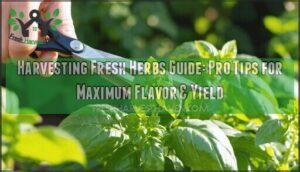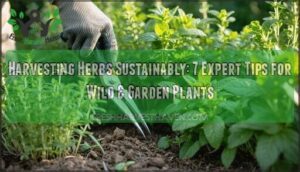This site is supported by our readers. We may earn a commission, at no cost to you, if you purchase through links.
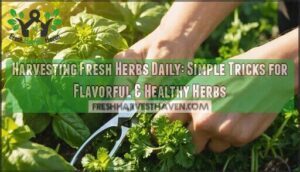
When you’re harvesting fresh herbs daily, you’re actually encouraging stronger growth—it’s like giving your plants a daily pep talk that makes them bushier and more productive.
Start in the morning when essential oils are strongest, using clean scissors or your fingers to pinch stems just above leaf pairs.
This regular attention prevents herbs from going to seed prematurely and keeps flavors at their peak intensity.
Don’t worry about taking too much; most herbs thrive on frequent harvesting, especially basil, cilantro, and parsley.
Your kitchen will thank you, and your herb garden will respond with vigorous new growth.
The secret timing and technique differences between annual and perennial herbs can make all the difference.
Table Of Contents
- Key Takeaways
- Harvesting Fresh Herbs
- Choosing Herbs to Harvest
- When to Harvest Herbs
- How to Harvest Herbs
- Harvesting Herbs for Preservation
- Maximizing Herb Yields
- Common Herb Harvesting Mistakes
- Enjoying Fresh Harvested Herbs
- Frequently Asked Questions (FAQs)
- How often should you harvest herbs?
- Can culinary herbs be harvested?
- When should you harvest herbs for drying?
- How do I harvest from my herb garden?
- What happens if you wait too long to harvest herbs?
- What herbs are harvested?
- Is it better to freeze or dry fresh herbs?
- How do I maximize my herb harvest?
- When should you harvest dried herbs?
- How do you harvest herbs in the morning?
- Conclusion
Key Takeaways
- Harvest daily to boost growth – Regular cutting triggers your herbs’ natural defense response, producing more essential oils and encouraging bushier, more productive plants.
- Time it right for peak flavor – Pick herbs in the early morning after the dew dries but before the heat builds, when essential oil concentration is at its strongest.
- Use proper cutting technique – Cut stems just above leaf nodes using clean, sharp tools, taking no more than one-third of the plant to maintain health and encourage regrowth.
- Start with fast-growing varieties – Focus on basil, cilantro, parsley, and mint since they recover quickly from frequent harvesting and actually produce more when cut regularly.
Harvesting Fresh Herbs
You’ll discover that harvesting fresh herbs daily transforms both your garden and your kitchen in remarkable ways.
This simple practice keeps your plants healthy while ensuring you always have peak-flavor herbs ready for your next meal, which makes it a great way to have peak-flavor herbs.
Benefits of Daily Harvesting
Daily harvesting transforms your herb garden into a powerhouse of Flavor Intensity and Nutrient Density. When you pick herbs regularly, you’re triggering their natural defense mechanism—they respond by producing more essential oils and developing stronger flavors.
Regular harvesting triggers your herbs’ natural defense response, intensifying essential oils and maximizing flavor.
This daily harvesting practice creates a Continuous Supply of fresh herbs while promoting Enhanced Growth patterns. Your plants become bushier and more productive with each snip.
- Boosted herb flavor through stress-response oil production
- Reduced Waste by preventing herbs from bolting to seed
- Improved herb freshness with peak morning essential oil content
- Accelerated herb regrowth through strategic cutting techniques
Tools for Harvesting Herbs
When you’re ready to snip, grab your favorite herb harvesting tools. Herb snips are perfect for soft stems—just keep them sharp and clean for easy cutting.
Hand pruners and garden shears handle the thicker, woody stems, so choose rust-proof pruning tools for long-term use. Don’t forget durable gloves; leather or nitrile Glove Materials protect your hands from prickly herbs.
Basket Types matter, too—a lined harvest basket keeps leaves fresh and bruise-free. Proper tools can improve harvest efficiency.
Store your tools in a dry spot, and try Snip Alternatives for delicate herbs.
Harvesting Techniques for Annual Herbs
For annual herbs like basil and cilantro, proper harvesting techniques guarantee continuous growth and maximum flavor.
These fast-growing plants respond well to frequent cutting when done correctly.
Here are three essential harvesting techniques for annual herbs:
- Cut above leaf nodes – Make clean cuts just above where leaves meet the stem to promote annual regrowth and prevent damage that leads to bolting prevention.
- Harvest outer stems first – Remove mature outer growth while leaving center stems intact for flavor maximization and continued production.
- Take only one-third maximum – Never harvest more than 33% at once to maintain plant strength for successive planting cycles and seed saving opportunities.
Harvesting Techniques for Perennial Herbs
Unlike annual herbs, perennial herbs need a "cut-and-come-again" approach that keeps them productive year after year.
**Keep cutting, keep growing—your herbs reward regular harvests with explosive productivity.
You’ll cut woody stem harvesting candidates like rosemary and sage above leaf nodes, using sharp pruners for clean cuts.
For mint and oregano, pinch growing tips to encourage bushier growth.
Remember the one-third rule – never harvest more than that in one go.
Root harvesting works best in spring/fall when energy moves underground.
After pruning after flowering, these plants bounce back stronger.
Your harvesting techniques for perennial herbs should focus on long-term plant health.
Choosing Herbs to Harvest
You’ll want to pick herbs that are ready for harvesting and will benefit from regular cutting.
Start with fast-growing varieties like basil, mint, cilantro, and parsley since they recover quickly and actually produce more when harvested frequently.
Benefits of Regular Exercise
When you harvest fresh herbs regularly, it’s like giving your body a natural Energy Boost.
Herb harvesting supports Mental Clarity, Disease Prevention, and even Weight Management.
You’ll notice Mood Improvement too—there’s something uplifting about tending to your plants.
Embrace herb benefits for your overall herb health and herb wellness, making every day a little brighter and healthier.
Tips for Healthy Habits
Daily harvesting herbs creates healthy habits that nourish both body and mind.
Establish a Balanced Diet by incorporating fresh herbs into meals, ensuring Regular Hydration while tending your herb garden, and practicing Mindful Eating as you select aromatic leaves.
This routine promotes Adequate Sleep through evening garden walks and natural Stress Reduction from connecting with nature’s rhythms.
Overcoming Common Fitness Challenges
Several motivation strategies can help you overcome fitness obstacles, much like tending a garden requires patience.
Set realistic goals and track progress weekly for sustainable goal setting. Practice injury prevention by warming up properly and listening to your body’s signals.
Master time management by scheduling workouts like you’d plan herb harvesting timing—consistency matters more than duration.
Maintain diet consistency by meal prepping, just as gardeners prepare tools for harvesting fresh herbs using proven herb harvesting best practices.
When to Harvest Herbs
Timing your herb harvest correctly makes all the difference between bland and brilliant flavors in your cooking.
You’ll want to pick your herbs when their essential oils are at their peak concentration, which happens during specific times of day and weather conditions, to ensure the best flavor, making brilliant flavors a key outcome.
Harvesting at Peak Flavor
Knowing when your herbs hit their flavor peak transforms ordinary cooking into culinary magic.
Your herbs’ Essential Oil Peak occurs just before flowering, when Leaf Flavor Intensity reaches maximum concentration.
Research shows basil’s linalool content jumps 30% during this sweet spot.
Perfect Harvest Conditions for herb flavor enhancement include:
- Morning Harvest Time after dew dries but before heat strikes
- Targeting young, fully-expanded leaves for Taste Before Flowering
- Checking plants twice weekly during active growth
- Feeling for slightly sticky, oil-rich leaves
- Harvesting fresh herbs when aroma peaks naturally
Smart herb harvesting timing preserves those precious volatile compounds that make your dishes sing.
Harvesting in Morning or Afternoon
Morning hours deliver peak flavor through maximum oil concentration. You’ll capture herbs at their most aromatic after dew evaporates but before heat builds.
Afternoon harvesting works when schedules demand flexibility, though optimal time remains early day. Harvesting herbs just before they flower helps to capture peak flavor.
| Time Period | Benefits |
|---|---|
| Early Morning | Peak oil concentration, maximum flavor |
| Mid-Morning | Good flavor retention, manageable heat |
| Early Afternoon | Convenient timing, moderate quality |
| Late Afternoon | Declining oils, potential leaf bitterness |
Weather impact affects quality—cooler temperatures preserve essential oils better. Your herb harvesting timing tips should prioritize morning collection for herb harvesting for fresh use.
Avoiding Harvesting in Extreme Weather
Weather extremes can turn your herb harvesting techniques into a disaster.
Heat stress scorches leaves, while frost damage destroys delicate tissues. Both conditions compromise herb flavor preservation and plant health.
Rain effects create soggy, bruised herbs prone to rot. Wind impact causes physical damage and moisture loss. Sunburn risk peaks during intense afternoon sun.
Smart herb harvesting time of day means avoiding these conditions entirely. Wait for calm, moderate weather when harvesting herbs—your plants will reward you with better flavors and continued growth throughout the herb harvesting time of year.
How to Harvest Herbs
You’ll master the art of harvesting herbs with the right technique, turning your daily picking into a skill that keeps plants healthy and productive.
Whether you’re pinching soft stems or using sharp tools for woody herbs, the method you choose determines both your harvest quality and your plant’s future growth.
Pinching Vs Cutting Herbs
Which technique suits your herb best? Pinching benefits soft culinary herbs by redirecting energy to side shoots, creating bushier growth. Cutting regrowth works better for woody herbs, promoting multiple harvests.
Tool selection matters – fingertips for delicate basil, pruning techniques with shears for thicker stems.
**Pinching above a node for bushier herbs like basil or rosemary.
**Cut stems close to the dirt for chives.
**Trim oregano’s edges to control spread.
**Leave lower leaves when cutting sage.
- **Match your herb cutting technique to the plant type – soft herbs respond well to pinching, while woody varieties need clean cuts for superior herb pruning results.
To guarantee the best flavor, harvest herbs by identifying signs of readiness.
Using Pruning Shears or Scissors
Your herb scissors’ sharpness makes all the difference in successful herb harvesting.
Clean cuts from quality pruning shears prevent plant damage and encourage healthy regrowth. Choose herb cutting tools based on stem thickness—delicate herb scissors for soft herbs, sturdy pruning shears for woody varieties.
Maintain proper cutting angles just above leaf nodes. Regular shear maintenance keeps blades sharp and clean.
Consider specialized cutting tools for efficiency. Quality herb harvesting tools and equipment guarantee your plants thrive with each harvest and support healthy regrowth through proper cutting angles.
Harvesting Herb Leaves or Stems
Choosing between harvesting herb leaves or stems depends on your cooking needs and plant health goals.
Smart gardeners know that Leaf Node Cuts above growth points trigger fresh shoots, while proper Stem Selection maintains plant vigor.
- Target tender stems for maximum flavor – young growth packs more essential oils
- Practice Partial Harvesting by taking only outer stems, leaving center growth intact
- Maintain Tool Sharpness for clean cuts that prevent disease and encourage faster healing
- Focus on Regrowth Boost by cutting just above leaf pairs to double your branching points
This approach guarantees continuous herb harvesting for leaves and stems while keeping plants thriving season-long.
Harvesting Herbs for Preservation
Fresh herbs don’t have to be used immediately after harvesting—you can preserve them to enjoy their flavors year-round.
Whether you’re drying, freezing, or pickling your herbs, proper preservation techniques help you make the most of your garden’s bounty while maintaining peak flavor and nutritional value.
Drying Herbs for Long-Term Storage
For maximum flavor retention, proper herb drying transforms your fresh harvest into year-round seasoning gold.
Air drying works perfectly for low-moisture herbs like rosemary and thyme—simply hang bundles upside down in a warm, ventilated space.
Oven drying and microwave drying speed the process, while dehydrator use offers consistent results.
Proper equipment can improve herb drying success.
Store your dried treasures in airtight containers away from light for ideal herb preservation and herb storage.
Freezing Herbs for Fresh Flavor
Freezing Methods lock in that garden-fresh taste you’ve worked so hard to grow.
Blanching herbs first—a quick boil followed by an ice bath—preserves vibrant color and flavor preservation.
Try oil infusion in ice cube trays for easy cooking portions, or flash-freeze whole leaves on baking sheets before transferring to herb storage bags.
These herb preservation techniques keep your harvest ready year-round.
Pickling Herbs for Added Flavor
While freezing locks in freshness, pickling transforms your herbs into tangy flavor powerhouses.
This time-tested herb preservation technique creates bold taste combinations that’ll make your taste buds dance.
Here’s your pickling roadmap:
- Create your brine: Combine equal parts vinegar and water with salt, experimenting with different vinegar choices like apple cider or white wine
- Layer herb combinations: Pack jars with sturdy herbs like dill, thyme, or rosemary
- Store properly: Refrigerate for maximum storage duration of 2-3 months
These pickling methods reveal incredible herb flavor profiles. For best results, remember to harvest in morning for peak flavor.
Maximizing Herb Yields
Getting the most from your herb garden means understanding how smart harvesting actually boosts plant productivity.
By using proper pruning techniques, providing adequate nutrition, and maintaining soil moisture, you’ll encourage your herbs to produce more leaves throughout the growing season, which is crucial for plant productivity.
Pruning for Bushy Growth
Strategic pruning transforms scraggly herb plants into lush, productive powerhouses. Node Placement matters most—cut stems just above leaf nodes where new branches emerge. Tool Sharpness guarantees clean cuts that heal quickly, so keep your herb pruning shears razor-sharp.
Focus on Stem Selection by targeting leggy growth and spent flowers first. Pruning Frequency depends on growth rate, but weekly herb pinching of soft tips works wonders.
Follow proper herb cutting guidelines: never remove more than one-third at once. This Growth Stimulation technique maximizes your herb regrowth potential while maintaining plant health. Regular herb harvesting through strategic pruning keeps plants compact and continuously productive.
Pruning Techniques Tool Needed Frequency Benefit
Fertilizing for Healthy Herbs
Strong herbs need proper nourishment to flourish. Organic fertilizers like compost tea and fish emulsion provide gentle, steady nutrition that won’t compromise essential oils.
Apply diluted liquid fertilizer every 2-4 weeks for container herbs, less frequently for garden beds.
Synthetic fertilizers work faster but can reduce flavor intensity.
Test your soil annually to understand nutrient requirements and adjust your fertilizer application accordingly for ideal herb plant health.
Mulching for Retaining Moisture
Around your herb garden, smart mulching locks in precious moisture.
Apply mulch types like straw, shredded leaves, or bark chips at two-to-three-inch application depth.
This herb mulching technique reduces watering frequency, improves soil health, and supports your herb harvesting goals.
The mulch benefits include temperature regulation and weed suppression—essential herb garden care that boosts herb harvesting frequency while maintaining ideal herb garden tips.
Common Herb Harvesting Mistakes
Even experienced gardeners make simple harvesting mistakes that can weaken plants or reduce flavor quality.
You’ll damage your herb garden’s productivity if you harvest too much at once, wait too long between cuttings, or pick at the wrong times of day, which can lead to weakened plants and reduced flavor quality.
Over-Harvesting Herbs
Why risk your herb garden’s future? Plant stress from herb overharvesting leads to weakened growth and reduced yield.
Excessive herb harvesting frequency causes flavor loss and potential herb death.
Follow proper herb harvesting guidelines: never exceed one-third weekly harvest limits. Smart herb yield management prevents overstressing plants, ensuring your herb harvesting guide keeps gardens thriving season after season.
Under-Harvesting Herbs
Your herbs’ missed potential shows when you skip regular harvesting.
Under-harvesting causes stunted growth, flavor loss, and reduced yield. Plants become leggy and stressed without proper herb harvesting.
This herb underharvesting prevents the cut-and-come-again method that keeps plants productive.
Regular trimming maintains plant health and guarantees fresh herbs for your herb harvesting for cooking, herb harvesting for salads, and herb harvesting for soups needs.
Harvesting Herbs at Wrong Time
Timing your herb harvesting wrong can sabotage flavor and aroma.
Midday heat reduces oil concentration and causes plant stress, leading to bitterness risk and slower regrowth.
Herb harvesting for essential oils works best in early morning after dew dries but before 10 AM.
This timing preserves flavor while minimizing stress on your plants for maximum regrowth impact.
Enjoying Fresh Harvested Herbs
Once you’ve harvested your herbs, you’ll want to put them to good use right away to enjoy their peak flavor and aroma.
Fresh herbs transform ordinary meals into culinary masterpieces, whether you’re adding them to your favorite recipes or creating special herb-infused treats.
Using Herbs in Cooking and Baking
Why limit your herb harvesting efforts to just growing when you can transform every meal? Cooking with herbs reveals incredible herb flavors that’ll make your dishes sing. Fresh herb recipes become your secret weapon for turning simple ingredients into restaurant-quality meals.
- Add savory herbs like rosemary and thyme early for deep flavor infusion in slow-cooked dishes
- Toss delicate herbs such as basil at the end to preserve their aromatic oils
- Experiment with herb pairings – mint with lamb, sage with pork, or cilantro with spicy foods
- Use sweet herbs like lavender sparingly in desserts for sophisticated baking infusions
Master these herb culinary uses and watch ordinary cooking become extraordinary. Your taste buds will thank you for the upgrade!
Making Herb Butters and Oils
Fresh herb butters and herb oils reveal your harvest’s full potential. Combine softened butter with chopped herbs using a 4:1 butter ratio—four parts butter to one part herbs.
For oils, gentle infusion methods work best. You can even create delicious herb-infused soups with your fresh herbs.
| Oil Types | Best Herb Combinations |
|---|---|
| Olive Oil | Rosemary, thyme, oregano |
| Avocado Oil | Basil, garlic, parsley |
| Grapeseed Oil | Chives, dill, tarragon |
| Sunflower Oil | Sage, mint, cilantro |
| Coconut Oil | Lemon balm, lavender |
Storage safety matters—refrigerate herb butters for two weeks, oils for one month maximum.
Creating Herbal Teas and Infusions
Beyond herb butters, your harvested herbs can brew into soothing herbal teas and infusions. Fresh mint, chamomile, or lemon balm create flavorful blends that showcase your herb harvesting skills.
- Tea Herb Selection: Choose fresh herbs like peppermint for energy or chamomile for relaxation
- Infusion Methods: Steep herbs 5-15 minutes in hot water for maximum flavor extraction
- Flavor Combinations: Mix herbs like mint-lemon balm or rosemary-thyme for unique taste profiles
Store dried herbs in airtight containers to preserve their health benefits year-round.
Frequently Asked Questions (FAQs)
How often should you harvest herbs?
Sarah’s backyard basil thrived because she harvested it every few days, pinching stems above leaf nodes.
You should harvest herbs 2-3 times weekly during growing season, taking no more than one-third of each plant to encourage continuous growth and allow for regular harvesting.
Can culinary herbs be harvested?
Yes, you can absolutely harvest culinary herbs.
Cut stems above leaf nodes regularly to encourage bushy growth.
Harvest before flowering for peak flavor, and never take more than one-third at once.
When should you harvest herbs for drying?
Picture bundling oregano sprigs like tiny bouquets on a warm August morning.
You’ll harvest herbs for drying just before they flower, when essential oils peak.
Choose dry mornings after dew evaporates for maximum flavor concentration.
How do I harvest from my herb garden?
Use sharp, clean shears to cut stems above leaf nodes, taking no more than one-third of each plant.
Harvest in early morning after dew dries for peak flavor and essential oils.
What happens if you wait too long to harvest herbs?
Like forgotten fruit left too long on the vine, neglected herbs lose their prized essence.
You’ll harvest bitter, woody leaves as essential oils concentrate in flowers instead of foliage, leaving your culinary treasures tough and unpalatable.
What herbs are harvested?
You can harvest most culinary herbs including basil, parsley, cilantro, chives, thyme, oregano, rosemary, mint, dill, and sage for fresh daily use in cooking.
Is it better to freeze or dry fresh herbs?
Fresh herbs become culinary gold when you choose the right preservation path.
For delicate herbs like basil and cilantro, freezing preserves flavor better than drying.
For hardy herbs like rosemary and thyme, drying concentrates their essence beautifully.
How do I maximize my herb harvest?
Pick herbs in early morning after dew dries.
Cut stems above leaf nodes, removing only one-third at a time.
Harvest regularly to prevent flowering and encourage new growth for continuous production.
When should you harvest dried herbs?
Studies show herbs retain 85% more essential oils when harvested at peak dryness.
You’ll want to harvest dried herbs when seeds turn brown and papery, typically late summer.
Cut seed heads on calm, dry mornings before pods split open naturally, ensuring the essential oils are preserved.
How do you harvest herbs in the morning?
Wait until morning dew evaporates but before the sun gets hot. Cut stems above leaf nodes using sharp scissors or pruning shears for clean cuts that promote regrowth.
Conclusion
Congratulations, you’ve officially become that neighbor who smugly waves around perfect herbs while others struggle with sad, wilted grocery store specimens.
Your commitment to harvesting fresh herbs daily has transformed your garden into a culinary goldmine that keeps producing more the more you take.
You’ve mastered the art of encouraging vigorous growth through regular harvesting, perfected your timing, and discovered preservation techniques that extend your harvest.
Now you can enjoy restaurant-quality flavors in every meal.
- https://www.gardenary.com/blog/your-complete-guide-to-harvesting-herbs-from-your-garden
- https://www.thespruce.com/harvesting-herbs-for-growth-5270569
- https://content.ces.ncsu.edu/harvesting-and-preserving-herbs-for-the-home-gardener
- https://growagoodlife.com/harvest-dry-herbs/
- https://www.planetnatural.com/herb-gardening-guru/harvesting-preserving-herbs/

